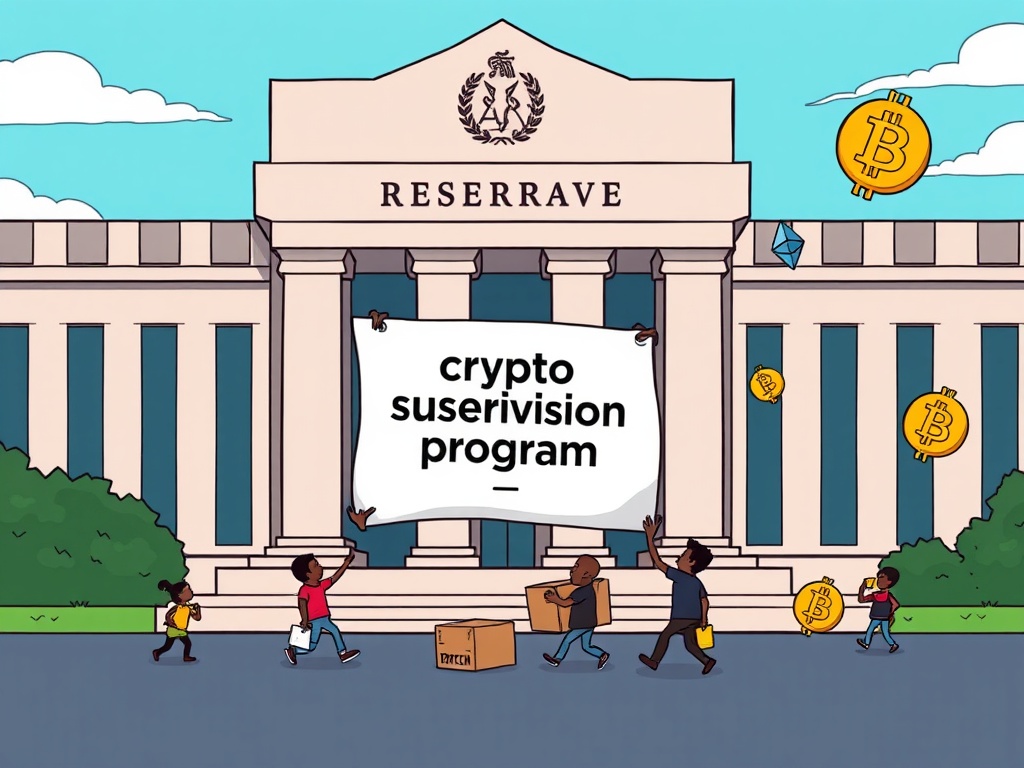Fed Crypto Supervision Program: A Crucial Shift in US Digital Asset Oversight
0
0

BitcoinWorld

Fed Crypto Supervision Program: A Crucial Shift in US Digital Asset Oversight
The financial world is buzzing with recent news that the Federal Reserve has made a significant decision. They are disbanding their “novel activities” program, which previously oversaw banks’ cryptocurrency and fintech endeavors. This move, as reported by the Walter Bloomberg economic news account on X, signals a crucial moment for the Fed crypto supervision program and the broader landscape of digital assets in the United States.
What Exactly Was the Fed Crypto Supervision Program?
For those unfamiliar, the “novel activities” unit was not just a casual committee. It was a dedicated initiative within the Federal Reserve designed to provide specialized guidance and oversight for financial institutions venturing into complex and innovative areas. This included emerging technologies like blockchain, digital assets, and various other fintech activities.
- Primary Purpose: The program’s main goal was to ensure that banks adequately managed the unique risks associated with these rapidly evolving technologies.
- Scope: It focused on areas where traditional banking regulations might not have fully covered the nuances of new digital financial products and services.
Its existence highlighted the Fed’s proactive stance in monitoring the intersection of traditional finance and the burgeoning crypto space.
Why is the Federal Reserve Realigning its Crypto Regulation Approach?
The decision to disband this specialized program might initially seem surprising, especially given the ongoing interest in digital assets. However, this move could indicate a maturation of the regulatory approach rather than an abandonment of oversight. Several factors might be at play:
- Regulatory Maturation: The Fed may believe that direct, centralized oversight for “novel activities” is less necessary now. This could be because crypto and related technologies are becoming more integrated into traditional financial systems.
- Integration into Existing Frameworks: It’s possible the Fed intends to embed crypto considerations more deeply into its existing, broader banking supervision frameworks. This suggests a shift towards a more holistic approach to crypto regulation.
- Evolving Understanding: Regulators have gained a deeper understanding of digital assets over time, potentially leading to a revised strategy for managing associated risks.
This shift does not mean an end to regulatory scrutiny, but rather an evolution in how that scrutiny is applied.
How Does This Impact Banks and Digital Asset Oversight?
For financial institutions, particularly banks that have been exploring or engaging with digital assets, this disbandment carries direct implications. The oversight will likely shift from a specialized unit to more integrated supervision within existing regulatory structures.
- Operational Changes: Banks might find their processes simplified as they no longer need to navigate a separate “novel activities” program.
- New Challenges: Conversely, they might face new challenges in adapting to a less specialized, but potentially broader, regulatory environment where crypto risks are assessed alongside traditional financial risks.
- Focus on General Risk Management: For digital asset oversight, the emphasis may increasingly fall on general risk management principles. This includes areas like cybersecurity, anti-money laundering (AML), and consumer protection, rather than specific crypto-centric rules.
The industry will need to adapt quickly to these evolving expectations.
What’s Next for US Crypto Policy?
The disbandment of the Fed crypto supervision program certainly doesn’t imply a free-for-all in the digital asset space. Instead, it suggests a strategic move towards embedding crypto considerations into existing banking supervision. Other key agencies, such as the Office of the Comptroller of the Currency (OCC) and the Federal Deposit Insurance Corporation (FDIC), also play crucial roles in regulating financial institutions.
The future of US crypto policy will likely involve a more coordinated, yet less siloed, approach across various regulatory bodies. This development highlights an ongoing debate within regulatory circles about how best to manage innovation while simultaneously maintaining financial stability and protecting consumers. Stakeholders across the crypto and traditional finance sectors will be watching closely for further guidance and frameworks.
In conclusion, the Federal Reserve’s decision to disband its “novel activities” program marks a significant inflection point for the Fed crypto supervision program. It is not an abandonment of oversight but rather a strategic realignment, aiming for a more integrated and perhaps more mature approach to crypto regulation. This move will undoubtedly shape how banks engage with digital assets and influence the evolving landscape of fintech activities and overall US crypto policy for years to come.
Frequently Asked Questions (FAQs)
1. What was the Federal Reserve’s “novel activities” program?
The “novel activities” program was a specialized unit within the Federal Reserve dedicated to overseeing banks’ engagement with emerging technologies like cryptocurrency and other fintech activities, ensuring they managed associated risks.
2. Why is the Fed disbanding its crypto supervision program?
The disbandment likely signals a maturation of the Fed’s approach to digital assets, potentially integrating crypto oversight into broader, existing banking supervision frameworks rather than maintaining a separate, specialized unit.
3. Does this mean there will be less crypto regulation in the US?
Not necessarily. While the specific program is being disbanded, it suggests a shift towards embedding crypto considerations into existing regulatory structures, rather than a reduction in overall crypto regulation or digital asset oversight.
4. How will this affect banks involved in fintech activities?
Banks might experience a shift in how their digital asset endeavors are supervised, moving from a dedicated program to more integrated oversight within general banking regulations. This could simplify some processes or introduce new compliance challenges.
5. What is the future of US crypto policy after this decision?
The future of US crypto policy is expected to involve a more coordinated approach among various regulatory bodies (Fed, OCC, FDIC), integrating crypto oversight into broader financial stability and risk management frameworks.
If you found this article informative, please share it with your network! Your insights and discussions help illuminate the evolving world of cryptocurrency and financial regulation. Let’s keep the conversation going on social media!
To learn more about the latest crypto market trends, explore our article on key developments shaping Bitcoin institutional adoption.
This post Fed Crypto Supervision Program: A Crucial Shift in US Digital Asset Oversight first appeared on BitcoinWorld and is written by Editorial Team
0
0
 Manage all your crypto, NFT and DeFi from one place
Manage all your crypto, NFT and DeFi from one placeSecurely connect the portfolio you’re using to start.





